| History of the United States | |
|---|---|
 This article is part of a series | |
| Timeline | |
| Pre-Colonial period | |
| Colonial period | |
| 1776–1789 | |
| 1789–1849 | |
| 1849–1865 | |
| 1865–1918 | |
| 1918–1945 | |
| 1945–1964 | |
| 1964–1980 | |
| 1980–1991 | |
| 1991–present | |
| Topic | |
| Civil Rights (1896–1954) | |
| Civil Rights (1955–1968) | |
| Civil War | |
| Cultural history | |
| Demographic history | |
| Diplomatic history | |
| Economic history | |
| History of the South | |
| Military history | |
| Technological and industrial history | |
| Territorial evolution | |
| Women's history | |
| United States Portal |
The history of the United States traditionally starts with the Declaration of Independence in the year 1776, yet its territory was occupied first by the Native Americans since prehistoric times and then also by European colonists who followed the voyages of Christopher Columbus starting in 1492. The largest settlements were by the English on the East Coast, starting in 1607. By the 1770s the Thirteen Colonies contained two and half million people, were prosperous, and had developed their own political and legal systems. The British government's threat to American self-government led to war in 1775 and the Declaration of Independence in 1776. With major military and financial support from France, the patriots won the American Revolution. In 1789 the Constitution became the basis for the United States federal government, with war hero George Washington as the first president. The young nation continued to struggle with the scope of central government and with European influence, creating the first political parties in the 1790s, and fighting a second war for independence in 1812.
U.S. territory expanded westward across the continent, brushing aside Native Americans and Mexico, and overcoming modernizers who wanted to deepen the economy rather than expand the geography. Slavery of Africans was abolished in the North, but heavy world demand for cotton let it flourish in the Southern states. The 1860 election of Abraham Lincoln calling for no more expansion of slavery triggered a crisis as eleven slave states seceded to found the Confederate States of America in 1861. The bloody American Civil War (1861–65) redefined the nation and remains the central iconic event. The South was defeated and, in the Reconstruction era, the U.S. ended slavery, extended rights to African Americans, and readmitted secessionist states with loyal governments. The national government was much stronger, and it now had the explicit duty to protect individuals. Reconstruction was rolled back by the white South, leaving the blacks in a world of Jim Crow political, social and economic inferiority. The entire South remained poor while the North and West grew rapidly.
Thanks to an outburst of entrepreneurship in the North and the arrival of millions of immigrant workers from Europe, the U.S. became the leading industrialized power by 1900. Disgust with corruption, waste, and traditional politics stimulated the Progressive movement, 1890s-1920s, which pushed for reform in industry and politics and put into the Constitution women's suffrage and Prohibition of alcohol (the latter repealed in 1933). Initially neutral in World War I, the U.S. declared war on Germany in 1917, and funded the Allied victory. The nation refused to follow President Woodrow Wilson's leadership and never joined the League of Nations. After a prosperous decade in the 1920s the Wall Street Crash of 1929 marked the onset of the decade-long world-wide Great Depression. A political realignment expelled the Republicans from power and installed Democrat Franklin D. Roosevelt and his elaborate and expensive New Deal programs for relief, recovery, and reform. Roosevelt's Democratic coalition, comprising ethics in the north, labor unions, big-city machines, intellectuals, and the white South, dominated national politics into the 1960s. After the Japanese attack on Pearl Harbor in December 1941, the U.S. entered World War II alongside the Allies and helped defeat Nazi Germany in Europe and, with the detonation of newly-invented atomic bombs, Japan in Asia and the Pacific.
The Soviet Union and the U.S. emerged as opposing superpowers after the war and began the Cold War confronting indirectly in an arms race, the Space Race, and intervention in Europe and eastern Asia. Liberalism reflected in the civil rights movement and opposition to war in Vietnam peaked in the 1960s–70s before giving way to conservatism in the early 1980s. The Cold War ended when the Soviet Union dissolved in 1991, leaving the U.S. to prosper in the booming Information Age economy that was boosted, at least in part, by information technology. International conflict and economic uncertainty heightened by 2001 with the September 11 attacks and subsequent War on Terror and the late-2000s recession.
Contents[hide]
|
[edit] Pre-Columbian era
It is not definitively known how or when the Native Americans first settled the Americas and the present-day United States. The prevailing theory proposes that people migrated from Eurasia across Beringia, a land bridge that connected Siberia to present-day Alaska, and then spread southward throughout the Americas. This migration might have begun as early as 30,000 years ago[1] and continued through to about 10,000 years ago, when the land bridge became submerged by the rising sea level caused by the ending of the last glacial period.[2] These early inhabitants, called Paleoamericans, soon diversified into many hundreds of culturally distinct nations and tribes.
The pre-Columbian era incorporates all period subdivisions in the history and prehistory of the Americas before the appearance of significant European influences on the American continents, spanning the time of the original settlement in the Upper Paleolithic period to European colonization during the Early Modern period. While technically referring to the era before Christopher Columbus' voyages of 1492 to 1504, in practice the term usually includes the history of American indigenous cultures until they were conquered or significantly influenced by Europeans, even if this happened decades or even centuries after Columbus' initial landing.
[edit] Colonial period

After a period of exploration by people from various European countries, Spanish, Dutch, English, French, Swedish, and Portuguese settlements were established. In the 16th century, Europeans brought horses, cattle, and hogs to the Americas and, in turn, took back to Europe maize, potatoes, tobacco, beans, and squash. The disease environment was very unhealthy for explorers and early settlers. The Native Americans became exposed to new diseases such as smallpox and measles and died in very large numbers, usually before large-scale European settlement began.
[edit] Spanish, Dutch, and French colonization
Spanish explorers were the first Europeans to arrive in what is now the United States with Christopher Columbus' second expedition, which reached Puerto Rico on November 19, 1493; others reached Florida in 1513.[3] Quickly Spanish expeditions reached the Appalachian Mountains, the Mississippi River, the Grand Canyon[4] and the Great Plains. In 1540, Hernando de Soto undertook an extensive exploration of Southeast. Also in 1540 Francisco Vázquez de Coronado explored from Arizona to central Kansas.[5] The Spanish sent some settlers, creating the first permanent European settlement in the continental United States at St. Augustine, Florida in 1565, but it attracted few permanent settlers. Much larger and more important Spanish settlements included Santa Fe, Albuquerque, San Antonio, Tucson, San Diego, Los Angeles and San Francisco.[6]

New Netherland was the 17th century Dutch colony centered on New York City and the Hudson River Valley, where they traded furs with the Native Americans to the north and were a barrier to Yankee expansion from New England. The Dutch were Calvinists who built the Reformed Church in America, but they were tolerant of other religions and cultures. The colony was taken over by Britain in 1664. It left an enduring legacy on American cultural and political life, including a secular broadmindedness and mercantile pragmatism in the city, a rural traditionalism in the countryside typified by the story of Rip Van Winkle, and politicians such as Martin Van Buren, Theodore Roosevelt, Franklin D. Roosevelt and Eleanor Roosevelt.[7]
New France was the area colonized by France from 1534 to 1763. There were few permanent settlers outside Quebec, but Indian tribes often became military allies in France's wars with Britain. After 1750 the Acadians—French settlers who had been expelled by the British from Acadia (Nova Scotia)—resettled in Louisiana, where they developed a distinctive rural Cajun culture that still exists. They became American citizens in 1803 with the Louisiana Purchase.[8] Other French villages along the Mississippi and Illinois rivers were absorbed when the Americans started arriving after 1770.
[edit] British colonization

The strip of land along the eastern seacoast was settled primarily by English colonists in the 17th century, along with much smaller numbers of Dutch and Swedes. Colonial America was defined by a severe labor shortage that employed forms of unfree labor such as slavery and indentured servitude,[10] and by a British policy of benign neglect (salutary neglect) that permitted the development of an American spirit distinct from that of its European founders.[11] Over half of all European immigrants to Colonial America arrived as indentured servants.[12]
The first successful English colony was established in 1607, on the James River at Jamestown. It languished for decades until a new wave of settlers arrived in the late 17th century and established commercial agriculture based on tobacco. Between the late 1610s and the Revolution, the British shipped an estimated 50,000 convicts to their American colonies.[13] One example of conflict between Native Americans and English settlers was the 1622 Powhatan uprising in Virginia, in which Native Americans had killed hundreds of English settlers. The largest conflict between Native Americans and English settlers in the 17th century was King Philip's War in New England,[14] although the Yamasee War may have been bloodier.[15]
The Plymouth Colony was established in 1620. New England was initially settled primarily by Puritans who established the Massachusetts Bay Colony in 1630.[16] The Middle Colonies, consisting of the present-day states of New York, New Jersey, Pennsylvania, and Delaware, were characterized by a large degree of diversity. The first attempted English settlement south of Virginia was the Province of Carolina, with Georgia Colony the last of the Thirteen Colonies established in 1733.[17] Methodism became the prevalent religion among colonial citizens after the First Great Awakening, a religious revival led by preacher Jonathan Edwards in 1734.[16]
[edit] Political integration and autonomy
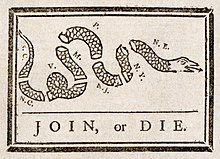
The French and Indian War (1754–1763) was a watershed event in the political development of the colonies. The influence of the main rivals of the British Crown in the colonies and Canada, the French and North American Indians, was significantly reduced. Moreover, the war effort resulted in greater political integration of the colonies, as symbolized by Benjamin Franklin's call for the colonies to "Join or Die".
Following Britain's acquisition of French territory in North America, King George III issued the Royal Proclamation of 1763 with the goal of organizing the new North American empire and stabilizing relations with the native Indians. In ensuing years, strains developed in the relations between the colonists and the Crown. The British Parliament passed the Stamp Act of 1765, imposing a tax on the colonies to help pay for troops stationed in North America following the British victory in the Seven Years' War.
The British government felt that the colonies were the primary beneficiaries of this military presence, and should pay at least a portion of the expense. The colonists did not share this view. Rather, with the French and Indian threat diminished, the primary outside influence remained that of Britain. A conflict of economic interests increased with the right of the British Parliament to govern the colonies without representation being called into question.
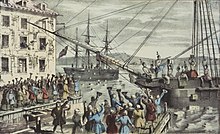
The Boston Tea Party in 1773 was a direct action by colonists in the town of Boston to protest against the taxes levied by the British government. Parliament responded the next year with the Coercive Acts, which sparked outrage and resistance in the Thirteen Colonies. Colonists convened the First Continental Congress to coordinate their resistance to the Coercive Acts. The Congress called for a boycott of British trade, published a list of rights and grievances, and petitioned the king for redress of those grievances.
The Congress also called for another meeting if their petition did not halt enforcement of the Coercive Acts. Their appeal to the Crown had no effect, and so the Second Continental Congress was convened in 1775 to organize the defense of the colonies at the onset of the American Revolutionary War.
[edit] Formation of the United States of America (1776–1789)
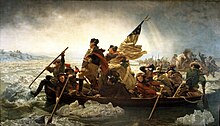
The Thirteen Colonies began a rebellion against British rule in 1775 and proclaimed their independence in 1776 as the United States of America. In the American Revolutionary War (1775-1783) the American capture of the British invasion army at Saratoga in 1777 secured the Northeast and encouraged the French to make a military alliance with the United States. France brought in Spain and the Netherlands, thus balancing the military and naval forces on each side as Britain had no allies.[19] General George Washington (1732-1799) proved an excellent organizer and administrator, who worked successfully with Congress and the state governors, selecting and mentoring his senior officers, supporting and training his troops, and maintaining an idealistic Republican Army. His biggest challenge was logistics, since neither Congress nor the states had the funding to provide adequately for the equipment, munitions, clothing, paychecks, or even the food supply of the soldiers. As a battlefield tactician Washington was often outmaneuvered by his British counterparts. As a strategist, however, he had a better idea of how to win the war than they did. The British sent four invasion armies. Washington's strategy forced the first army out of Boston in 1776, and was responsible for the surrender of the second and third armies at Saratoga (1777) and Yorktown (1781). He limited the British control to New York and a few places while keeping Patriot control of the great majority of the population. The Loyalists, whom the British counted upon too heavily, comprised about 20% of the population but never were well organized. As the war ended, Washington watched proudly as the final British army quietly sailed out of New York City in November 1783, taking the Loyalist leadership with them. Washington astonished the world when instead of seizing power for himself, he retired quietly to his farm in Virginia. [20] Political scientist Seymour Martin Lipset observes, "The United States was the first major colony successfully to revolt against colonial rule. In this sense, it was the first 'new nation'."[21]

On July 4, 1776, the Second Continental Congress, meeting in Philadelphia, declared the independence of "the United States of America" in the Declaration of Independence. July 4 is celebrated as the nation's birthday. The new nation was founded on Enlightenment ideals of liberalism in what Thomas Jefferson called the unalienable rights to "life, liberty and the pursuit of happiness," and dedicated strrongly to republican principles. Republicanism emphasized the people are sovereign (not hereditary kings), demanded civic duty, feared corruption, and rejected any aristocracy.[22]
In the 1780s the national government was able to settle the issue of the western territories, which were ceded by the states to Congress and became territories; soon they became states. Nationalists worried that the new nation was too fragile to withstand an international war, or even internal revolts such as the Shays' Rebellion of 1786 in Massachusetts. Nationalists—most of them war veterans—organized in every state and convinced Congress to call the Philadelphia Convention in 1787. The delegates from every state wrote a new Constitution that created a much more powerful and efficient central government, one with a strong president, and powers of taxation. The new government reflected the prevailing republican ideals of guarantees of individual liberty and upon constraining the power of government through a system of separation of powers.[23]
To assuage the Anti-Federalists who feared a too-powerful national government, the nation adopted the United States Bill of Rights in 1791. Comprising the first ten amendments of the Constitution, it guaranteed individual liberties such as freedom of speech and religious practice, jury trials, and stated that citizens and states had reserved rights (which were not specified).[24]
[edit] Early national era (1789–1849)
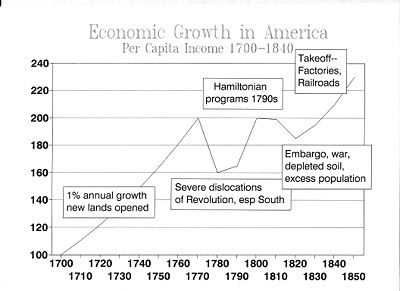
George Washington—a renowned hero of the American Revolutionary War, commander-in-chief of the Continental Army, and president of the Constitutional Convention—became the first President of the United States under the new Constitution in 1789.
The major accomplishments of the Washington Administration were creating a strong national government that was recognized without question by all Americans, and, following the plans of Treasury Secretary Alexander Hamilton, assuming the debts of the states (the debt holders received federal bonds), creating the Bank of the United States to stabilize the financial system, setting up a uniform system of tariffs (taxes on imports) and other taxes to pay off the debt and provide a financial infrastructure. To support his programs Hamilton created a new political party—the first in the world based on voters—the Federalist Party. Thomas Jefferson and James Madison led the opposition, forming an opposition Republican Party (usually called the Democratic-Republican Party by historians). Hamilton and Washington presented the country in 1794 with the Jay Treaty that reestablished good relations with Britain. The Jeffersonians vehemently protested, and the voters aligned behind one party or the other, thus setting up the First Party System. The treaty passed, but politics became very heated.[25]
The Whiskey Rebellion in 1794, when western settlers protested against a federal tax on liquor, was the first serious test of the federal government. Washington called out the state militia and personally led an army, as the insurgents melted away and the power of the national government was firmly established.[26]
Washington refused to serve more than two terms--setting a precedent--and in famous his farewell address, he extolled the benefits of federal government and importance of ethics and morality while warning against foreign alliances and formation of political parties.[27]
John Adams, a Federalist, defeated Jefferson in the 1796 election. War loomed with France and the Federalists used the opportunity to try to silence the Republicans with the Alien and Sedition Acts, build up a large army with Hamilton at the head, and prepare for a French invasion. However, the Federalists became divided after Adams sent a successful peace mission to France that ended the Quasi-War of 1798. Jefferson defeated Adams for the presidency in the 1800 election.[28]
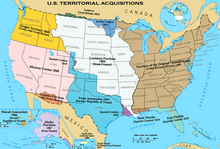
Although the Constitution included a Supreme Court, its functions were vague until John Marshall, the Chief Justice (1801–35), defined them, especially the power to overturn acts of Congress that violated the Constitution, first enunciated in 1803 in Marbury v. Madison.[29] The Louisiana Purchase, in 1803, removed the French presence from the western border of the United States and provided U.S. settlers with vast potential for expansion west of the Mississippi River.[30]
In response to multiple grievances, the Congress declared war on Britain in 1812. The grievances included humiliating the Americans in the Chesapeake incident of 1807, continued British impressment of American sailors into the Royal Navy, restrictions on trade with France, and arming hostile Indians in Ohio and the western territories.[31] The War of 1812 ended in a draw after bitter fighting that lasted until January 8, 1815, during the Battle of New Orleans. The Americans gained no territory but were cheered by a sense of victory in what they called a "second war of independence". The war was a major loss for Native American tribes in the Northwest and Southeast who had allied themselves with Britain and were defeated on the battlefield.
As strong opponents of the war, the Federalists held the Hartford Convention in 1814 that hinted at disunion. National euphoria after the victory at New Orleans ruined the prestige of the Federalists and they no longer played a significant role.[32] President Madison and most Republicans realized it had been a mistake to let the Bank of the United States close down, for its absence greatly hindered the financing of the war. So they chartered the Second Bank of the United States in 1816. The Republicans also imposed tariffs designed to protect the infant industries that had been created when Britain was blockading the U.S. With the collapse of the Federalists as a party, the adoption of many Federalist principles by the Republicans, and the systematic policy of President James Monroe in his two terms (1817–25) to downplay partisanship, the nation entered an Era of Good Feelings, with far less partisanship than before (or after), and closed out the First Party System.[33][34]
The Monroe Doctrine, expressed in 1823, proclaimed the United States' opinion that European powers should no longer colonize or interfere in the Americas. This was a defining moment in the foreign policy of the United States. The Monroe Doctrine was adopted in response to American and British fears over Russian and French expansion into the Western Hemisphere.[35]
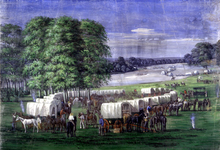
In 1830, Congress passed the Indian Removal Act, which authorized the president to negotiate treaties that exchanged Native American tribal lands in the eastern states for lands west of the Mississippi River. This established Andrew Jackson, a military hero and President, as a proponent of the forcible removal of native populations to the West.[36] The act resulted most notably in the Trail of Tears, a forced migration of several native tribes to the West, with several thousand people dying en route, and the Creeks' violent opposition and eventual defeat. The Indian Removal Act also directly caused the ceding of Spanish Florida and led to the many Seminole Wars.[37]
After 1840 the abolitionist movement redefined itself, mobilized its supporters (especially among religious people in the Northeast affected by the Second Great Awakening), escalated its attacks, and proclaimed slave ownership a sin, not just an unfortunate social evil. It gained tens of thousands of followers. William Lloyd Garrison published the most influential of the many anti-slavery newspapers, The Liberator, while Frederick Douglass, an ex-slave, began writing for that newspaper around 1840 and started his own abolitionist newspaper North Star in 1847.[38]
The Republic of Texas was annexed in 1845.[39] The U.S. army, using regulars and large numbers of volunteers, defeated Mexico in 1848 during the Mexican-American War. Public sentiment in the U.S. was divided as Whigs[40] and anti-slavery forces[41] opposed the war. The 1848 Treaty of Guadalupe Hidalgo ceded California, New Mexico, and adjacent areas to the United States, about thirty percent of Mexico. Westward expansion was enhanced further by the California Gold Rush, the discovery of gold in that state in 1848. Numerous "forty-niners" trekked to California in pursuit of gold; land-hungry European immigrants also contributed to the rising white population in the west.[16] In 1849 cholera spread along the California and Oregon Trails. An estimated 150,000 Americans died during the two cholera pandemics between 1832 and 1849.[42]
[edit] Civil War era (1849–1865)

The Confederacy: brown
*territories in light shades
In the middle of the 19th century, white Americans of the North and South were to reconcile fundamental differences in their approach to government, economics, society and African American slavery. The issue of slavery in the new territories was settled by the Compromise of 1850 brokered by Whig Henry Clay and Democrat Stephen Douglas; the Compromise included admission of California as a free state and the passage of the Fugitive Slave Act to make it easier for masters to reclaim runaway slaves.[39] In 1854, the proposed Kansas-Nebraska Act abrogated the Missouri Compromise by providing that each new state of the Union would decide its stance on slavery.[43]
By 1860, there were nearly four million slaves residing in the United States, nearly eight times as many from 1790; within the same time period, cotton production in the U.S. boomed from less than a thousand tons to nearly one million tons per year. There were some slave rebellions—including by Gabriel Prosser (1800), Denmark Vesey (1822), and Nat Turner (1831)—but they all failed and led to tighter slave oversight in the south.[44]
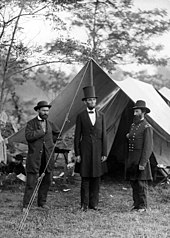
After Abraham Lincoln won the 1860 election, eleven Southern states seceded from the union between late 1860 and 1861, establishing a new government, the Confederate States of America, on February 8, 1861.[45] Along with the northwestern portion of Virginia, which became West Virginia, four of the five northernmost "slave states" did not secede and became known as the Border States.[45]
[edit] Civil War
The Civil War began on April 12, 1861, when Confederate forces attacked a U.S. military installation at Fort Sumter in South Carolina.[46] In response to the attack, on April 15, Lincoln called on the states to send detachments totaling 75,000 troops to recapture forts, protect the capital, and "preserve the Union", which in his view still existed intact despite the actions of the seceding states. The two armies had their first major clash at the First Battle of Bull Run, which ended in a surprising Union defeat, but, more importantly, proved to both the Union and Confederacy that the war was going be much longer and bloodier than they had originally anticipated.
The war soon divided into two theaters: Eastern and Western. In the western theater, the Union was quite successful, with major battles, such as Perryville, producing strategic Union victories and destroying major confederate operations.

In the Eastern theater, things did not start well for the Union. In the summer of 1861, General Irvin McDowell was given the task of destroying the Confederacy in one quick battle with the newly created Army of Northeastern Virginia. Union and Confederate forces engaged in combat at Manassas Junction (Bull Run), which resulted in a surprising Union defeat due in part to steadfast Confederate defense. Following McDowell's failure, Major General George B. McClellan was put in charge of the Union armies. After reorganizing the new Army of the Potomac, McClellan failed to capture the Confederate capital of Richmond, Virginia in his Peninsula Campaign and retreated after attacks from newly appointed Confederate General Robert E. Lee.
Feeling confident in his army after defeating the Union at Second Bull Run, Lee embarked on an invasion of the north that was stopped by McClellan at the bloody Battle of Antietam. Despite this, McClellan was relieved from command for refusing to pursue Lee's crippled army. The next commander, General Ambrose Burnside, suffered a humiliating defeat by Lee's smaller army at the Battle of Fredericksburg late in 1862, causing yet another change in commanders. Lee won again at the Battle of Chancellorsville in May 1863, while losing his top aide, Stonewall Jackson. But Lee pushed too hard and ignored the Union threat in the west.[citation needed] Lee invaded Pennsylvania in search of supplies and to cause war weariness in the North. In perhaps the turning point of the war, Lee's army was badly beaten at the Battle of Gettysburg, July 1–3, 1863, and barely made it back to Virginia.
Simultaneously on July 4, 1863, Union forces under the command of General Ulysses S. Grant gained control of the Mississippi River at the Battle of Vicksburg, thereby splitting the Confederacy. Lincoln made General Grant commander of all Union armies.
The last two years of the war was bloody for both sides, with Grant launching a war of attrition against General Lee's Army of Northern Virginia. This war of attrition was divided into three main campaigns. The first of these, the Overland Campaign forced Lee to retreat into the city of Petersburg where Grant launched his second major offensive, the Richmond-Petersburg Campaign in which he sieged Petersburg. After a near ten-month siege, Petersburg surrendered. However, the defense of Fort Gregg allowed Lee to move his army out of Petersburg. Grant pursued and launched the final, Appomattox Campaign which resulted in Lee surrendering his Army of Northern Virginia on April 9, 1865, at Appomattox Court House.[45] Other Confederate armies followed suit and the war ended.
Based on 1860 census figures, about 8% of all white males aged 13 to 43 died in the war, including about 6% in the North and approximately 18% in the South,[47] establishing the American Civil War as the deadliest war in American history. Its legacy includes ending slavery in the United States, restoring the Union, and strengthening the role of the federal government. The social, political, economic and racial issues of the war decisively shaped the Reconstruction era, which lasted through 1877, and brought about changes that would eventually help make the country a united superpower.
[edit] Reconstruction and a rise in power (1865–1918)
[edit] Reconstruction

Reconstruction took place for most of the decade following the Civil War. During this era, the "Reconstruction Amendments" were passed to expand civil rights for black Americans. Those amendments included the Thirteenth Amendment, which outlawed slavery, the Fourteenth Amendment that guaranteed citizenship for all people born or naturalized within U.S. territory, and the Fifteenth Amendment that granted the vote for all men regardless of race. While the Civil Rights Act of 1875 forbade discrimination in the service of public facilities, the Black Codes denied blacks privileges readily available to whites.[48]
In response to Reconstruction, the Ku Klux Klan (KKK) emerged around the late 1860s as a white-supremacist organization opposed to black civil rights. Congress passed the Ku Klux Klan Act of 1870 and vigorous enforcement closed down the Klan and classified the KKK as a terrorist group. However, an 1883 Supreme Court decision nullified the Civil Rights Act of 1875 and ended federal efforts to stop private acts of violence designed to suppress legal rights.[49]
During the era, many regions of the southern U.S. were military-governed and often corrupt; Reconstruction ended after the disputed 1876 election between Republican candidate Rutherford B. Hayes and Democratic candidate Samuel J. Tilden. Hayes won the election, and the South soon re-entered the national political scene.[50]
[edit] Gilded Age and Progressivism
The "Gilded Age" was a term that Mark Twain used to describe the period of the late 19th century when there had been a dramatic expansion of American wealth and prosperity. Reform of the Age included the Civil Service Act, which mandated a competitive examination for applicants for government jobs. Other important legislation included the Interstate Commerce Act, which ended railroads' discrimination against small shippers, and the Sherman Antitrust Act, which outlawed monopolies in business. Twain believed that this age was corrupted by such elements as land speculators, scandalous politics, and unethical business practices.[51]
By 1890 American industrial production and per capita income exceeded those of all other world nations. In response to heavy debts and decreasing farm prices, wheat and cotton farmers joined the Populist Party.[52] An unprecedented wave of immigration from Europe served both to provide the labor for American industry and create diverse communities in previously undeveloped areas. From 1880 to 1914, peak years of immigration, more than 22 million people migrated to the United States.[53] The workers' demand for control of their workplace led to the often violent rise of the labor movement in the cities and mining camps. Industrial leaders included John D. Rockefeller in oil and Andrew Carnegie in steel; both became leaders of philanthropy, giving away their fortunes to create the modern system of hospitals, universities, libraries and foundations.

Dissatisfaction on the part of the growing middle class with the corruption and inefficiency of politics as usual, and the failure to deal with increasingly important urban and industrial problems, led to the dynamic Progressive Movement starting in the 1890s. In every major city and state, and at the national level as well, and in education, medicine, and industry, the progressives called for the modernization and reform of decrepit institutions, the elimination of corruption in politics, and the introduction of efficiency as a criteria for change. Leading politicians from both parties, most notably Theodore Roosevelt, Charles Evans Hughes, and Robert LaFollette on the Republican side, and William Jennings Bryan on the Democratic side, took up the cause of progressive reform. Women became especially involved in demands for woman suffrage, prohibition, and better schools; their most prominent leader was Jane Addams of Chicago. Progressives implemented anti-trust laws and regulated such industries of meat-packing, drugs, and railroads. Four new constitutional amendments—the Sixteenth through Nineteenth—resulted from progressive activism, bringing the federal income tax, direct election of Senators, prohibition, and woman suffrage.[55] The Progressive Movement lasted through the 1920s; the most active period was 1900–1918.[56]
[edit] Imperialism
The United States emerged as a world economic and military power after 1890. The main episode was the Spanish–American War, which began when Spain refused American demands to reform its oppressive policies in Cuba. The "splendid little war", as one official called it, involved a series of quick American victories on land and at sea. At the Treaty of Paris peace conference the United States acquired the Philippines, Puerto Rico, and Guam. Cuba became an independent country, under close American tutelage. Although the war itself was widely popular, the peace terms proved controversial. William Jennings Bryan led his Democratic Party in opposition to control of the Philippines, which he denounced as imperialism unbecoming to American democracy. President William McKinley defended the acquisition, and was riding high as the nation had returned to prosperity and felt triumphant in the war. McKinley easily defeated Bryan in a rematch in the 1900 presidential election. After defeating an insurrection by Filipino nationalists, the United States engaged in a large scale program to modernize the economy of the Philippines, and dramatically upgrade the public health facilities.[57] By 1908, however, Americans lost interest in an empire, and turned their international attention to the Caribbean, and especially the building of the Panama Canal. The canal opened in 1914, and increased trade with Japan and the rest of the Far East. A key innovation was the Open Door Policy, whereby the imperial powers were given equal access to Chinese business, with no one of them allowed to take control of China.[58]
[edit] World War I
While World War I raged in Europe from 1914, the U.S. pursued a policy of neutrality until disputes with Germany over unrestricted submarine warfare, among other disagreements, erupted into an American declaration of war in April 1917.[59] The U.S. had previously shown interest in world peace by participating in the Hague Conferences. American involvement in the war proved essential to the Allied victory in 1918. President Woodrow Wilson also implemented a set of propositions titled the Fourteen Points to ensure peace, but they were denied at the 1919 Paris Peace Conference. Isolationist sentiment following the war also blocked the U.S. from participating in the League of Nations, an important part of the Treaty of Versailles.[16]
[edit] Woman suffrage

The women's suffrage movement began with the 1848 Seneca Falls Convention, organized by Elizabeth Cady Stanton and Lucretia Mott, and the Declaration of Sentiments demanding equal rights for women. Many of the activists became politically aware during the abolitionist movement. The women's rights campaign during "first-wave feminism" was led by Mott, Stanton, Susan B. Anthony, among many others. The movement reorganized after the Civil War, gaining experienced campaigners, many of whom had worked for prohibition in the Women's Christian Temperance Union. By the end of the 19th century a few western states had granted women full voting rights,[60] though women had made significant legal victories, gaining rights in areas such as property and child custody.[61]
Around 1912 the feminist movement, which had grown sluggish, began to reawaken, putting an emphasis on its demands for equality and arguing that the corruption of American politics demanded purification by women, because men could not do that job.[62] Protests became increasingly common as suffragette Alice Paul led parades through the capital and major cities. Paul split from the large National American Woman Suffrage Association (NAWSA), which favored a more moderate approach and supported the Democratic Party and Woodrow Wilson, led by Carrie Chapman Catt, and formed the more militant National Woman's Party. Suffragists were arrested during their "Silent Sentinels" pickets at the White House, the first time such a tactic was used, and were taken as political prisoners.[63]
Finally, the suffragettes were ordered released from prison, and Wilson urged Congress to pass a Constitutional amendment enfranchising women. The old anti-suffragist argument that only men could fight a war, and therefore only men deserve the right to vote, was refuted by the enthusiastic participation of tens of thousands of American women on the home front in World War I. Across the world, grateful nations gave women the right to vote. Furthermore, most of the Western states had already given the women the right to vote in state and national elections, and the representatives from those states, including the first woman Jeannette Rankin of Montana, demonstrated that woman suffrage was a success. The main resistance came from the south, where white leaders were worried about the threat of black women voting. Nevertheless Congress passed the Nineteenth Amendment in 1919. It became constitutional law on August 26, 1920, after ratification by the 36th required state.[64]
NAWSA became the League of Women Voters and the National Woman's Party began lobbying for full equality and the Equal Rights Amendment which would pass Congress during the second wave of the women's movement in 1972. Politicians responded to the new electorate by emphasizing issues of special interest to women, especially prohibition, child health, and world peace.[65][66] The main surge of women voting came in 1928, when the big-city machines realized they needed the support of women to elect Al Smith, while rural dries mobilized women to support Prohibition and vote for Republican Herbert Hoover.[67]
[edit] Roaring Twenties, the Great Depression, and World War II (1918–1945)

Following World War I, the U.S. grew steadily in stature as an economic and military world power. The United States Senate did not ratify the Treaty of Versailles imposed by its Allies on the defeated Central Powers; instead, the United States chose to pursue unilateralism, if not isolationism.[68] The aftershock of Russia's October Revolution resulted in real fears of communism in the United States, leading to a three-year Red Scare. In 1918 the U.S. lost 675,000 people to the Spanish flu pandemic.[69]
In 1920, the manufacture, sale, import and export of alcohol was prohibited by the Eighteenth Amendment. Prohibition encouraged illegal breweries and dealers to make substantial amounts of money selling alcohol illegally. The Prohibition ended in 1933, a failure. Additionally, the KKK re-formed during that decade and gathered nearly 4.5 million members by 1924, and the U.S. government passed the Immigration Act of 1924 restricting foreign immigration.[70] The 1920s were also known as the Roaring Twenties, due to the great economic prosperity during this period.[citation needed] Jazz became popular among the younger generation, and thus was also called the Jazz Age.
[edit] Great Depression
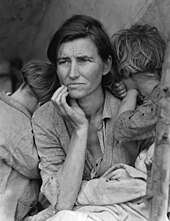
During most of the 1920s, the United States enjoyed a period of unbalanced prosperity: farm prices and wages fell, while new industries and industrial profits grew. The boom was fueled by an inflated stock market, which later led to the Stock Market Crash on October 29, 1929.[71] This, along with many other economic factors, triggered a worldwide depression known as the Great Depression. During this time, the United States experienced deflation, unemployment soared from 3% in 1929 to 25% in 1933, and manufacturing output collapsed by one-third.
In 1932, Democratic presidential nominee Franklin D. Roosevelt promised "a new deal for the American people",[72] a phrase that has endured as a label for his administration and its many domestic achievements. The desperate economic situation, along with the substantial Democratic victories in the 1932 elections, gave Roosevelt unusual influence over Congress in the "First Hundred Days" of his administration. He used his leverage to win rapid passage of a series of measures to create welfare programs and regulate the banking system, stock market, industry and agriculture, along with many other government efforts to end the Great Depression and reform the American economy. Some programs that were a part of Roosevelt's New Deal include the Works Progress Administration (WPA) relief program, the Social Security Act, the Emergency Banking Act, and the Economy Act. The recovery was rapid in all areas except unemployment,[citation needed] which decreased yet remained fairly high until 1940.[73]
[edit] World War II

In the Depression years the United States remained focused on domestic concerns while democracy declined across the world and many countries fell under the control of dictators. Imperial Japan asserted dominance in East Asia and in the Pacific. Nazi Germany and Fascist Italy militarized to and threatened conquests, while Britain and France attempted appeasement to avert another war in Europe. U.S. legislation in the Neutrality Acts sought to avoid foreign conflicts, however policy clashed with increasing anti-Nazi feelings following the German invasion of Poland in September 1939 that started World War II. Roosevelt positioned the U.S. as the "Arsenal of Democracy" pledging full-scale financial and munitions support for the Allies—but no soldiers.[74] Japan tried to neutralize America's power in the Pacific by attacking Pearl Harbor on December 7, 1941, which catalyzed American support to enter the war and seek revenge.[75]
The main contributions of the U.S. to the Allied war effort comprised money, industrial output, food, petroleum, technological innovation, and (especially 1944-45), soldiers. Much of the focus in Washington was maximizing the economic output of the nation. The overall result was a dramatic increase in GDP, the export of vast quantities of supplies to the Allies and to American forces overseas, the end of unemployment, and a rise in civilian consumption even as 40% of the GDP went to the war effort. This was achieved by tens of millions of workers moving from low-productivity occupations to high efficiency jobs, improvements in productivity through better technology and management, and the move into the active labor force of students, retired people, housewives, and the unemployed, and an increase in hours worked. It was exhausting; leisure activities declined sharply. People tolerated the extra work because of patriotism, the pay, and the confidence it was only "for the duration" and life would return to normal as soon as the war was won. Most durable goods became unavailable, and meat, clothing, and gasoline was tightly rationed. In industrial areas housing was in short supply as people doubled up and lived in cramped quarters. Prices and wages were controlled, and Americans saved a high portion of their incomes, which led to renewed growth after the war instead of a return to depression.[76][77]
The Allies--the U.S., Britain and the Soviet Union, as well as China, Canada and other countries—fought the Axis powers powers of Germany, Italy, and Japan. The Allies saw Germany the as main threat, and gave highest priority to Europe. The U.S. dominated the war against Japan, and stopped Japanese expansion in the Pacific in 1942. After losing top the Japanese Pearl Harbor and in the Philippines, and drawing the Battle of the Coral Sea (May 1942), the American Navy inflicted a decisive blow at Midway (June 1942). American ground forces assisted in the North African Campaign that eventually concluded with the collapse of Mussolini's fascist government in 1943, as Italy switched to the Allied side. A more significant European front was opened on D-Day, June 6, 1944, in which American and Allied forces invaded Nazi-occupied France from Britain.
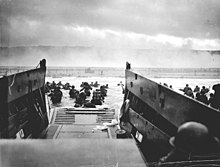
On the home front, mobilization of the U.S. economy was managed by Roosevelt's War Production Board. The wartime production boom led to full employment, wiping out this vestige of the Great Depression. Indeed, labor shortages encouraged industry to look for new sources of workers, finding new roles for women and blacks.[78]
However the fervor also inspired anti-Japanese sentiment, which responded by removing everyone of Japanese descent from the West Coast war zone.[79] Research and development took flight as well, best seen in the Manhattan Project, a secret effort to harness nuclear fission to produce highly-destructive atomic bombs.[80]
The Allied pushed the Germans out of France, but faced an unexpected counterattack at the Battle of the Bulge in December. The last-ditch German effort failed, and as 1945 opened Allied armies in East and West were converging on Berlin, as the Nazis hurriedly tried to kill the last remaining Jews. The western front stopped short, leaving Berlin to the Soviets as the Nazi regime formally capitulated in May 1945, ending the war in Europe.[81] Over in the Pacific, the U.S. implemented an island hopping strategy toward Tokyo, establishing airfields for bombing runs against mainland Japan from the Mariana Islandsand achieving hard-fought victories at Iwo Jima and Okinawa in 1945.[82] Bloodied at Okinawa, the U.S. prepared to invade Japane's home islands when B-29's dropped two atomic bombs on Japanese cities, forcing the empire's surrender in a matter of days and thus ending World War II.[83] The U.S. occupied Japan (and part of Germany), sending Douglas MacArthur to restructure the Japanese economy and political system along American lines.[84]
Though the nation lost more than 400,000 soldiers,[85] the mainland prospered untouched by the devastation of war that inflicted a heavy toll on Europe and Asia.
Participation in postwar foreign affairs marked the end of predominant American isolationism. The awesome threat of nuclear weapons inspired both optimism and fear. Nuclear weapons were never used after 1945, as both sides drew back from the brink and a "long peace" characterized the Cold War years, 1947–1991. There were, however, regional wars in Korea and Vietnam.[86]
[edit] The Cold War begins (1945–1964)

Following World War II, the United States emerged as one of the two dominant superpowers. The U.S. Senate on a bipartisan vote approved U.S. participation in the United Nations (UN), which marked a turn away from the traditional isolationism of the U.S. and toward more international involvement.
The primary American goal of 1945–48 was to rescue Europe from the devastation of World War II and to contain the expansion of Communism, represented by the Soviet Union. The Truman Doctrine of 1947 provided military and economic aid to Greece and Turkey to counteract the threat of Communist expansion in the Balkans. In 1948, the United States replaced piecemeal financial aid programs with a comprehensive Marshall Plan, which pumped money into the economy of Western Europe, and removed trade barriers, while modernizing the managerial practices of businesses and governments. The Plan's $13 billion budget was in the context of a U.S. GDP of $258 billion in 1948, and was on top of $12 billion in American aid to Europe between the end of the war and the start of the Marshall Plan. Soviet head of state Joseph Stalin prevented his satellites from participating, and from that point on Eastern Europe, with inefficient centralised economies, fell further and further behind Western Europe in terms of economic development and prosperity. In 1949, the United States, rejecting the long-standing policy of no military alliances in peacetime, formed the North Atlantic Treaty Organization (NATO) alliance, which continues into the 21st century. In response the Soviets formed the Warsaw Pact of communist states.[87]
In 1950 the Soviets tested their first nuclear weapon, thereby escalating the risk of warfare. Indeed, the threat of mutually assured destruction prevented both powers from going too far, and resulted in proxy wars, especially in Korea and Vietnam, in which the two sides did not directly confront each other.[86] Within the United States, the Cold War prompted concerns about Communist influence. The unexpected leapfrogging of American technology by the Soviets in 1957 with Sputnik, the first Earth satellite, began the Space Race, won by the Americans as Apollo 11 landed astronauts on the moon in 1969. The angst about the weaknesses of American education led to large-scale federal support for science education and research.[88]
In the decades after World War II, the United States became a global influence in economic, political, military, cultural, and technological affairs. Beginning in the 1950s, middle-class culture had a growing obsession with consumer goods. White Americans made up nearly 90% of the population in 1950.[89][clarification needed]
In 1960, the charismatic politician John F. Kennedy was elected as the first and—thus far—only Roman Catholic President of the United States. The Kennedy family brought a new life and vigor to the atmosphere of the White House. His time in office was marked by such notable events as the acceleration of the United States' role in the Space Race; escalation of the American role in the Vietnam War; the Cuban missile crisis; the Bay of Pigs Invasion; the jailing of Martin Luther King, Jr. during the Birmingham campaign; and the appointment of his brother Robert F. Kennedy to his Cabinet as Attorney General. Kennedy was assassinated in Dallas, Texas, on November 22, 1963, leaving the nation in profound shock.[90]
[edit] Climax of liberalism
The climax of liberalism came in the mid-1960s with the success of President Lyndon B. Johnson (1963–69) in securing congressional passage of his Great Society programs, including civil rights, the end of segregation, Medicare, extension of welfare, federal aid to education at all levels, subsidies for the arts and humanities, environmental activism, and a series of programs designed to wipe out poverty.[91][92] As recent historians have explained:
- "Gradually, liberal intellectuals crafted a new vision for achieving economic and social justice. The liberalism of the early 1960s contained no hint of radicalism, little disposition to revive new deal era crusades against concentrated economic power, and no intention to fast and class passions or redistribute wealth or restructure existing institutions. Internationally it was strongly anti-Communist. It aimed to defend the free world, to encourage economic growth at home, and to ensure that the resulting plenty was fairly distributed. Their agenda-much influenced by Keynesian economic theory-envisioned massive public expenditure that would speed economic growth, thus providing the public resources to fund larger welfare, housing, health, and educational programs."[93]
Johnson was rewarded with an electoral landslide in 1964 against conservative Barry Goldwater, which broke the decades-long control of Congress by the Conservative coalition. But the Republicans bounced back in 1966 and elected Richard Nixon in 1968. Nixon largely continued the New Deal and Great Society programs he inherited; conservative reaction would come with the election of Ronald Reagan in 1980.
[edit] The Civil Rights Movement
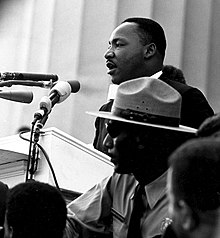
Meanwhile, the American people completed a great migration from farms into the cities and experienced a period of sustained economic expansion. At the same time, institutionalized racism across the United States, but especially in the South, was increasingly challenged by the growing Civil Rights movement. The activism of African American leaders Rosa Parks and Martin Luther King, Jr. led to the Montgomery Bus Boycott, which launched the movement. For years African Americans would struggle with violence against them, but would achieve great steps towards equality with Supreme Court decisions, including Brown v. Board of Education and Loving v. Virginia, the Civil Rights Act of 1964, the Voting Rights Act of 1965, and the Fair Housing Act of 1968, which ended the Jim Crow laws that legalized racial segregation between Whites and Blacks.
Martin Luther King, Jr., who had won the Nobel Peace Prize for his efforts to achieve equality of the races, was assassinated in 1968. Following his death others led the movement, most notably King's widow, Coretta Scott King, who was also active, like her husband, in the Opposition to the Vietnam War, and in the Women's Liberation Movement. Over the first nine months of 1967, 128 American cities suffered 164 riots.[94] The late 1960s and early 1970s saw the strengthening of Black Power, however the decade would ultimately bring about positive strides toward integration.
[edit] The Women's Movement

A new consciousness of the inequality of American women began sweeping the nation, starting with the 1963 publication of Betty Friedan's best-seller, The Feminine Mystique, which explained how many housewives felt trapped and unfulfilled, assaulted American culture for its creation of the notion that women could only find fulfillment through their roles as wives, mothers, and keepers of the home, and argued that women were just as able as men to do every type of job. In 1966 Friedan and others established the National Organization for Women, or NOW, to act for women as the NAACP did for African Americans.[61][95]
Protests began, and the new Women's Liberation Movement grew in size and power, gained much media attention, and, by 1968, had replaced the Civil Rights Movement as the U.S.'s main social revolution. Marches, parades, rallies, boycotts, and pickets brought out thousands, sometimes millions; Friedan's Women's Strike for Equality (1970) was a nation-wide success. The Movement was split into factions by political ideology early on, however (with NOW on the left, the Women's Equity Action League (WEAL) on the right, the National Women's Political Caucus (NWPC) in the center, and more radical groups formed by younger women on the far left).
Along with Friedan, Gloria Steinem was an important feminist leader, co-founding the NWPC, the Women's Action Alliance, and editing the Movement's magazine, Ms. The proposed Equal Rights Amendment to the Constitution, passed by Congress in 1972 and favored by about seventy percent of the American public, failed to be ratified in 1982, with only three more states needed to make it law. The nation's conservative women, led by activist Phyllis Schlafly, defeated the ERA by arguing that it degraded the position of the housewife, and made young women susceptible to the military draft.[96][97]
However, many federal laws (i.e. those equalizing pay, employment, education, employment opportunites, credit, ending pregnancy discrimination, and requiring NASA, the Military Academies, and other organizations to admit women), state laws (i.e. those ending spousal abuse and marital rape), Supreme Court rulings (i.e. ruling the equal protection clause of the Fourteenth Amendment applied to women), and state ERAs established women's equal status under the law, and social custom and consciousness began to change, accepting women's equality. The controversial issue of abortion, deemed by the Supreme Court as a fundamental right in Roe v. Wade (1973), is still a point of debate today.[98]
[edit] The Counterculture Revolution and Cold War Détente (1964–1980)
Amid the Cold War, the United States entered the Vietnam War, whose growing unpopularity fed already existing social movements, including those among women, minorities and young people. President Lyndon B. Johnson's Great Society social programs and the judicial activism[citation needed] of the Warren Court added to the wide range of social reform during the 1960s and 1970s. Feminism and the environmental movement became political forces, and progress continued toward civil rights for all Americans. The Counterculture Revolution swept through the nation and much of the western world in the late sixties and early seventies, dividing the already hostile environment but also bringing forth more liberated social views.

Johnson was succeeded by Republican Richard Nixon in 1969, who turned the war over to the South Vietnamese forces and ended American combat roles; he negotiated a peace treaty in 1973, secured the release of POWs and ended the draft. The war had cost the lives of 58,000 American troops. Nixon manipulated the fierce distrust between the Soviet Union and China to the advantage of the United States, achieving détente (cooperation) with both parties.[99] The Watergate scandal, involving Nixon's coverup of his operatives break-in into the Democratic National Committee headquarters at the Watergate office complex destroyed his political base, sent many aides to prison, and forced Nixon's resignation on August 9, 1974. He was succeeded by Vice President Gerald Ford, who was subsequently helpless to prevent the conquest of South Vietnam when North Vietnam invaded in 1975.[100]
The OPEC oil embargo marked a long-term economic transition, as for the first time energy prices skyrocketed and American factories faced serious competition from foreign automobiles, clothing, electronics and consumer goods. By the late 1970s the economy suffered an energy crisis, slow economic growth, high unemployment, and very high inflation coupled with high interest rates (the term stagflation was coined). While economists agreed on the wisdom of deregulation, many of the New Deal era regulations were ended, as in transportation, banking and telecommunications.[101]
Jimmy Carter, running as someone who was not a part of the Washington political establishment, was elected president in 1976.[102] On the world stage, Carter brokered the Camp David Accords between Israel and Egypt. In 1979, Iranian students stormed the U.S. embassy in Tehran and took 66 Americans hostage, resulting in the Iran hostage crisis. With the hostage crisis and continuing stagflation, Carter lost the 1980 election to the Republican Ronald Reagan.[103] On January 20, 1981, minutes after Carter's term in office ended, the remaining U.S. captives held at the U.S. embassy in Iran were released, ending the 444-day hostage crisis.[104]
[edit] The end of the Cold War (1980–1991)

Ronald Reagan produced a major realignment with his 1980 and 1984 landslide elections. Reagan's economic policies (dubbed "Reaganomics") and the implementation of the Economic Recovery Tax Act of 1981 lowered income taxes from 70% to 28% over the course of seven years.[citation needed] Reagan continued to downsize government taxation and regulation.[105] The U.S. experienced a recession in 1982; unemployment and business failures soon entered rates close to Depression-era levels. These negative trends reversed the following year, when the inflation rate decreased from 11% to 2%, the unemployment rate decreased from 10.8% in December 1982 to 7.5% in November 1984,[106] and the economic growth rate increased from 4.5% to 7.2%.[107]
Reagan ordered a massive buildup of the U.S. military, incurring a costly budget deficit. Reagan introduced a complicated missile defense system known as the Strategic Defense Initiative (dubbed "Star Wars" by opponents) in which the U.S. could, in theory, shoot down missiles with laser systems in space. Though it was never fully developed or deployed,[108] the Soviets were genuinely concerned about the possible effects of the program[109] and the research and technologies of SDI paved the way for the anti-ballistic missile systems of today.[110]
The Reagan administration also provided covert funding and assistance to anti-Communist resistance movements worldwide. Reagan's interventions against Grenada and Libya were popular in the U.S., though his backing of the Contra rebels was mired in controversy.[111] The arms-for-hostages scandal led to the convictions of such figures as Oliver North and John Poindexter.[112]
Reagan met four times with Soviet leader Mikhail Gorbachev, who ascended to power in 1985, and their summit conferences led to the signing of the Intermediate-Range Nuclear Forces Treaty. Gorbachev tried to save Communism in the Soviet Union first by ending the expensive arms race with America,[113] then by shedding the East European empire in 1989. The Soviet Union collapsed in 1991, ending the U.S.–Soviet Cold War.
[edit] World superpower (1991–present)
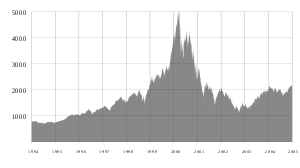
The United States emerged as the world's sole remaining superpower and continued to intervene in international affairs, including the 1991 Gulf War against Iraq. During the 1990s, President Bill Clinton oversaw one of the longest periods of economic expansion and unprecedented gains in securities values, a side effect of the digital revolution and new business opportunities created by the Internet. In 1998, Clinton was impeached by the House of Representatives on charges of "high crimes and misdemeanors" for lying about a sexual relationship with White House intern Monica Lewinsky. However, the Senate voted to acquit Clinton of the charges. The failure of impeachment and the Democratic gains in the 1998 election forced House Speaker Newt Gingrich, a Republican, to resign from Congress.[114]
The presidential election in 2000 between George W. Bush and Al Gore was one of the closest in U.S. history, and helped lay the seeds for political polarization to come. The vote in the decisive state of Florida was extremely close and produced a dramatic dispute over the counting of votes. The U.S. Supreme Court in Bush v. Gore ended the recount with a 5–4 vote. That meant Bush, then in the lead, carried Florida and the election.[115]
[edit] 9/11 and the War on Terror
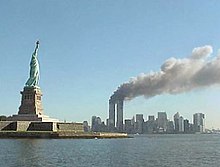
Once again the United States was attacked by terrorism with the September 11, 2001 attacks (9/11) in which al-Qaeda terrorists hijacked four transcontinental airliners and intentionally crashed two of them into the twin towers of the World Trade Center and one into the Pentagon killing 3,000 people.[116] President George W. Bush announced a "War on Terror" in response. The United States and NATO launched an invasion of Afghanistan to overthrow the Taliban regime that had harbored al-Qaeda and its founder, Osama bin Laden. The federal government established new domestic efforts to prevent future attacks. The controversial USA PATRIOT Act increased government's power to monitor communications and removed legal restrictions on information sharing between federal law enforcement and intelligence services. A cabinet-level agency called the Department of Homeland Security was created to lead and coordinate federal counter-terrorism activities.[117] Some of these anti-terrorism efforts, particularly the U.S. government's handling of detainees at the prison at Guantanamo Bay, led to allegations toward the U.S. government of human rights violations.[118]
In 2003, the United States launched an invasion of Iraq, which led to the collapse of the Iraqi government and the eventual capture of Iraqi dictator Saddam Hussein, whom the U.S. had long-standing tense relations with. The reasons for the invasion cited by the Bush administration included the spreading of democracy, the elimination of weapons of mass destruction[119] (a key demand of the UN as well, though later investigations found parts of the intelligence reports to be inaccurate)[120] and the liberation of the Iraqi people. The invasion and continued Iraq War fueled international protests and gradually saw domestic support waver,[121] despite initial successes early in the invasion. In 2007, after years of violence by the Iraqi insurgency, President Bush deployed more troops in a strategy dubbed "the surge". While the death toll decreased, the political stability of Iraq remained in doubt.[122]
In 2008, the unpopularity of President Bush and the Iraq war, along with the 2008 financial crisis, led to the election of Barack Obama, the first African American President of the United States. After he took offce, Obama began to decrease troop levels in Iraq, and officially ended combat operations in the country on August 31, 2010. At the same time, he kept 50,000 in Iraq to assist Iraqi forces, help protect withdrawing forces, and work on counter-terrorism until December 31, 2011, the date Bush scheduled for the full withdrawal.[123][124] Obama increased American involvement in Afghanistan, starting a surge strategy using an additional 30,000 troops, while proposing to begin withdrawing troops in July 2011.[125] In May 2011, after nearly a decade in hiding, Osama bin Laden was killed by U.S. armed forces acting under President Obama's direct orders, in a covert operation in Abbottabad, Pakistan, about 50 km (31 mi) north of Islamabad.[126]
[edit] Recent events

In December 2007, the United States, and most of Europe, entered the longest post–World War II recession,[127] which included a housing market crisis, a subprime mortgage crisis, soaring oil prices,[128] an automotive industry crisis, rising unemployment, and the worst financial crisis since the Great Depression.[129][130][131] The financial crisis hit a critical point in September 2008 when Lehman Brothers and other important financial institutions failed.[132] Starting the following month the federal government lent $245 billion to financial institutions through the Troubled Asset Relief Program.[133] Shortly after taking office, Obama signed into law a $787 billion economic stimulus package aimed at helping the economy recover from the deepening recession. In addition to the economic stimulus, the government took steps to rescue the auto industry and prevent future economic meltdowns. These included a bailout of General Motors and Chrysler, putting ownership temporarily in the hands of the government, and the "cash for clunkers" program which temporarily boosted new car sales.[134] Congress enacted the Dodd–Frank Wall Street Reform and Consumer Protection Act, making sweeping changes to financial regulation.[135] The recession officially ended in June 2009 as the U.S. economy began to expand once again,[136] however the unemployment rate has continued to linger near 9% and above into 2011.[137]
In the 111th Congress the GOP was unified in almost total opposition to the programs of the Congressional Democrats. Heated national debates emerged over numerous issues such as health care reform, which was rekindled by the Patient Protection and Affordable Care Act.[138] In the 2010 midterm elections, the Republicans regained control of the House of Representatives and cut into the Democratic majority in the Senate.[139] Another factor in these results was the Tea Party, a populist conservative movement that since 2009 has promoted political candidates and protests[140] with the goal of adherence to an originalist interpretation of the Constitution and reductions in government spending, taxes, and the federal budget deficit. As of 2011, debates continue over the economy, the 8.8% unemployment rate, deficit spending, health care reform, the financial crisis in state government, the role of corporate spending in election campaigns,[141] and U.S. involvement in Afghanistan and Libya.






No comments:
Post a Comment